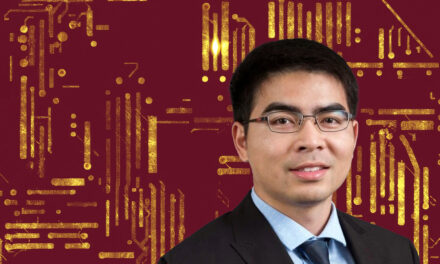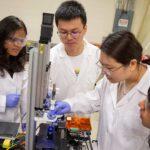
Consortium for Embedded Systems laying groundwork for global impact
February 12, 2007
One of Arizona State University’s most ambitious industry partnerships designed to spark technological innovation is setting the stage to expand its reach globally.
Sarma Vrudhula, a professor in the Ira A. Fulton School of Engineering Department of Computer Science and Engineering, has been appointed director of the Consortium for Embedded Systems and charged with establishing it as a leading force in development of technologies poised to have far-reaching impact on life in the 21st century.
The consortium operates within ASU’s new School of Computing and Informatics in the Ira A. Fulton School of Engineering.
Embedded systems are the computer microprocessors built into the electronic architecture of everything from satellites, space shuttles, medical equipment and automobiles to home appliances, cell phones, MP3 players and wristwatches.
“You can’t go through a typical day without encountering hundreds of small embedded computers in the products you use,” Vrudhula says.
Society’s increasing reliance on the services this technology provides is spawning a growing demand for embedded computers to perform more functions, he says.
He estimates the market for such advanced embedded systems could be close to $100 billion worldwide in the near future.
The idea for the consortium was proposed in 2000 by Motorola and Intel Corp. as part of efforts to make Arizona a global center for embedded systems.
The technical challenge for engineers is developing both the computer hardware and software to provide the processing power to expand the performance capacities of tiny microprocessors.
“One big goal is to see the kind of high-performance functions you have on your personal computer become available on your wireless hand-held electronics,” Vrudhula explains.
That means packing a lot of memory and high-quality digital, visual and audio functions into microprocessors — and doing it with low power consumption and cost-efficient manufacturing.
The consortium formed in 2001 with Intel and Motorola as the founding corporate partners. But to make advances as quickly and as wide-ranging as the consortium intends, it must tap resources of more of Arizona’s high-tech companies, Vrudhula says.
To give companies incentive to join, the consortium is developing “an industry-friendly intellectual property model to ensure corporate partners get substantial value for their investments,” he says.
”The intellectual property model is perhaps the most attractive feature of the industry-university partnership,” Vrudhula says. “Faculty members initiate research projects with an individual from a company, but the results are available to all consortium members. For one membership fee a company gets access to all the research initiated by our faculty in collaboration with other companies.”
ASU, the University of California at Irvine and Southern Illinois University have proposed that the National Science Foundation (NSF) make the consortium a federally designated industry-university cooperative research center (IUCRC), which will allow multiple universities and their industry partners to join the consortium.
Vrudhula says the NSF has indicated it will approve an IUCRC planning grant to aid expansion of the consortium.
“We expect to include many more universities across the country,” Vrudhula says. He also expects to bring more ASU faculty into the program.
“The works spans not only computer science but most of the departments in the Fulton School of Engineering, especially electrical engineering,” he says.
A number of Fulton School faculty and administrators have nurtured the consortium through its formative years, particularly Ben Huey, Sethuraman Panchanathan, Gregory Raupp and Steve Yau.
Huey was a founding member and co-director of the consortium board of directors, a recent board chair, and is now chair of the Division of Computing Studies at ASU’s Polytechnic campus.
Panchanathan, now director of the School of Computing and Informatics, led the consortium’s research committee for three years.
The Division of Computing Studies is undertaking an embedded systems curriculum project with funding from the consortium. The consortium operates within the Fulton School of Engineering, but faculty in the Electronics Systems Division of the Division of Computing Studies also is involved. Faculty at the Polytechnic campus will be given the same opportunity as Fulton School faculty at ASU’s main campus to compete for research and curriculum funding through the consortium.
At least 20 other engineering faculty members already have worked or are working with the consortium. Among them are computer science and engineering faculty Rida Bazzi, Karam Chatha, Charles Colbourn, Partha Dasgupta, Sandeep Gupta, Goran Konjevod, Yann-Hang Lee, Sethuraman Panchanathan, Arun Sen, Aviral Shrivastava, Violet Syrotiuk, Wei-Tek Tsai and Guoliang Xue.
Chatha, Lee and Shrivastava are working with Vrudhula to establish a foundation for the consortium.
Electrical engineering faculty includes Kevin Cao, Chaitali Chakrabarti, Lina Karam, Armando Rodriguez and Konstantinos Tsakalis. Faculty from the other departments, particularly mechanical and aerospace engineering, will be involved in the future.
The consortium has set down solid groundwork for expansion during its first five years. It is supporting more than 25 students each year in an industry internship program and more than 15 students in master’s and doctoral degree programs each year through ongoing research. More than 30 active faculty-led research projects are being supported with $2.1 million in funding.
The program has developed 16 undergraduate and graduate courses and related labs in embedded systems at the ASU Tempe campus and the ASU Polytechnic campus. The program is supporting study by about 50 students through graduate and undergraduate scholarships and fellowships.
Curriculum development has been based on industry-university gap analyses performed by the consortium, and has attracted some NSF funding. Curriculum has so far been developed primarily by Fulton School faculty at the Tempe campus with assistance from Polytechnic campus faculty members Tim Lindquist, Barbara Gannod, and Jerry Gannod. Harry Koehnemann, an associate professor in computing studies, is continuing the work.
“The consortium has been an integral part of the success of the computer systems program in the School of Computing and Informatics in terms of creating new curriculum, student internships and cutting-edge research,” says Panchanathan, director of the school. “It reflects the spirit of the interdisciplinary collaboration in computing and informatics, and we’re excited by the new vision and direction the consortium is going to take under professor Vrudhula’s leadership.”



































